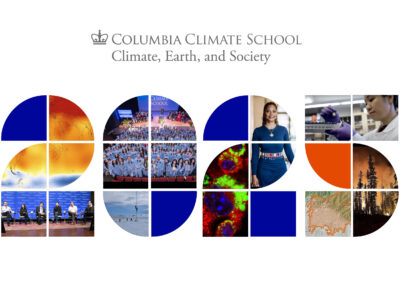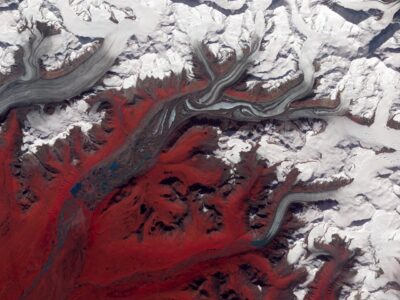
Few places afford a such a clear view of climate change as does Greenland, a frozen island in the Arctic about half the size of the United States, with a polar ice cap that’s three kilometers thick at its center. The melting of Greenland’s ice has accelerated over the past decades, and with it, rising sea levels. According to recent estimates, Greenland has lost around 270 billion tons of ice every year over the past few decades—equivalent to the weight of 26,000 Eiffel Towers—and which has contributed around 30-40% of the current global sea-level rise. Roughly half the ice loss occurs via ice calving at the ice sheet’s edge, while the other half happens through surface melting. Studying the reasons for the recent acceleration of Greenlandic surface melting and understanding the processes that control it are fundamental to improving estimates of what will happen to our oceans and the relative impact on our society.
This melting has occurred in tandem with the increase in CO2 emissions on a global scale, in stark contrast to the goals stated in the Paris Agreement, signed almost a decade ago. For this reason, understanding where and how quickly Greenland’s ice is melting is one of the keys to studying the effects of climate change on our planet, and the reason for a recent expedition to Greenland.

Accompanying me on this trip is Paolo Colosio, a young but highly trained research fellow at the University of Brescia and an expert in polar remote sensing; and Elizabeth Kolbert, a journalist who won the Pulitzer Prize in 2014 with her book, ‘The Sixth Extinction’. We will be staying in Kangerlussuaq, a town on the west coast with a population of around 500 people and the arrival point of international flights to Greenland. The Kangerlussuaq International Science Station (KISS) headquarters is here and will host us upon arrival. The temperature is pleasant, although experience teaches us that it could drop significantly and quickly as we get closer to the polar cap.
For previous expeditions, we have flown to the ice by helicopter. However, renting this transportation has become more challenging over the past years due to increased tourism in Greenland, which has driven up costs and reduced the availability of helicopters. This year, we reach the ice via a bumpy road built in the 1980s by a car company to test cars on the ice.
I have now exceeded a dozen expeditions to Greenland and I never tire of both the sight and the emotions of the first steps. The sound of the ice crushing under our heavy boots, the sight of the ice as far as the eye can see, simultaneously a lunar and yet familiar landscape, constantly triggering new emotions and raising scientific questions. It’s like being in the presence of an animal in danger of extinction, enormous and majestic but fragile under the attack of the tiny but powerful carbon dioxide molecules released by humans into the atmosphere. It is both a privilege and a curse to be here.

New and more powerful satellites, combined with increasingly refined climate models and artificial intelligence, have recently allowed us to make giant leaps in understanding what drives melting in Greenland. Despite these advances, it is still essential to explore new technologies, so we can continue adding more pieces to the complicated climate puzzle, promote solutions and test ideas. Carrying out these studies is not a purely scientific exercise. It is essential both for the remote future (hundreds of years) and the more immediate one (10-20 years), given the disastrous physical and economic impacts to which the population and infrastructure will be exposed as the Earth morphs into a new state. We no longer even have to wait for the future to know what will happen to us in some areas of our planet: the most recent extreme weather events, floods and wildfires have already shown us how the fate of coastal residents around the world depends on what happens in Greenland. The Greenland ice sheet is a time machine that offers a glimpse of the past through ice—and insight into what could happen to our planet and the cities we live in.
Drones are among the tools that make it possible to fill some of the most critical scientific gaps. They allow us to observe details within the ice that are not observable from satellites, and they offer an opportunity to discover or improve new processes that can be used within climate models. The drone we use in Greenland on this expedition collects images similar to those of a very high-resolution camera, along with other images that are invisible to our eyes but hold the secret of what is happening to the ice.

At first glance, it is logical to assume that Greenland’s increased melting is due to rising global temperatures. Indeed, that is true, but there’s more going on. One thing that significantly controls the melting of Greenland ice is the amount of solar energy absorbed by the ice, a parameter called “albedo,” from the Latin albus, or whiteness. We all know the albedo effect and the difference it makes in staying cool when wearing a white t-shirt instead of a black one on a sunny day. The same applies to Greenland, which becomes darker (lower albedo) or lighter (higher albedo) depending on melt-freeze cycles and precipitation. Heavy snowfall is equivalent to wearing a white shirt, since fresh snow favors the reflection of solar radiation, “cooling” the frozen island. Increased melting and refreezing cycles (as has been happening over the past decades) also alter the albedo: the snow absorbs more solar radiation as they occur. This phenomenon is, nevertheless, invisible to our eyes, but if we could see in the infrared region, we would see the snow becoming increasingly dark as it melts more and more. The melting and refreezing cycles further favor melting, increasing the absorption of solar radiation, in a sort of “melting cannibalism” in which the snow eliminates itself.
The Greenland ice sheet is a time machine that offers a glimpse of the past through ice—and insight into what could happen to our planet and the cities we live in.
We are freezing due to the strong wind coming down from the mountain of ice behind us. The wind does not make operations easier, and the work requires patience and stubbornness to operate the instruments. It is an effortless act in the office but an Olympic athlete’s stunt once on the ice. This same wind is also complicit in another phenomenon responsible for lowering the albedo in some areas, including where we are on this expedition. This time is it visible to our eyes, in the accumulation of substances such as ash, dust and sand on the frozen surface that makes the ice darker, favoring melting. The very fine material is deposited on the ice after being eroded by surrounding rocks or is caught by raindrops or snowflakes as they fall. Solar radiation heats the microscopic particles, forming small pools of water around them. These pools grow in size and depth, merge and give rise to micro-lakes ranging from a few centimeters to a few meters in length, in which the dark material composed of algae, bacteria, meteorite dust and other resilient animals continues to promote the melting of ice.

It takes longer we expect to collect the data due to the “usual” unforeseen events: drone batteries that the shipping company ruined and now run out more quickly than we expect; strong winds that limit the autonomy of the drone; the difficulty in crossing streams and waterways that are visibly swollen due to melting; fingers that can’t secure a small screw because of the cold. But in the end, we succeed. It will take months to analyze the data. Still, the good news is that preliminary analysis confirms the possibility of improving climate models and satellite data extraction using the data collected by our drone in conjunction with artificial intelligence techniques. The bad news is that our data also confirms that the glacier has thinned by several meters, in contrast with previous years when the change was much smaller.
Making things worse is the recent alteration of atmospheric circulation in the Arctic. The recent decrease in albedo has been accompanied by an increase in the amount of solar energy that reaches the ice. Changes in the Arctic atmosphere associated with climate change favor an increase in the number of cloudless days along many areas where melting is already accelerating, providing more “gas” for melting. The decrease in albedo and the increase in solar radiation reaching the ice are accomplices in a climate crime against Greenland. If melting is the speed of a train, the albedo is the slope of the train track, and solar radiation the gas we give to the train. Increasing the downhill slope and adding more gas will make the train run faster, eventually making it unstoppable.
Despite being geographically isolated and far from many densely populated places, Greenland and the melting of its ice influence our lives through sea level rise and the compounding effects of increased extreme weather, flooding and storms. As we search for solutions to reduce emissions and capture greenhouse gases, we must continue to study processes that lead to understanding how to reduce the uncertainties associated with projections of sea-level rise, ensuring that the future we predict does not arrive earlier than we anticipate, with many cities and regions unprepared to tackle the consequences. The incredible acceleration of the melting of the Greenland ice sheet holds a mirror to society and affects us all.

Marco Tedesco is a research professor at the Lamont-Doherty Earth Observatory, which is part of the Columbia Climate School.



